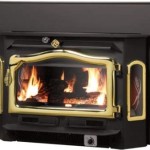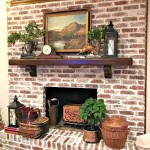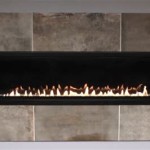Fireplace Design Considerations: Vents Located Above the Firebox
The integration of vents above a fireplace firebox represents a purposeful architectural and engineering decision, typically driven by the desire to improve heating efficiency, enhance aesthetic appeal, or address specific building code requirements. These vents, strategically positioned above the firebox opening, play a crucial role in managing the convective heat output of the fireplace and influencing the overall airflow dynamics within the surrounding space. A comprehensive understanding of their function and design implications is paramount for architects, builders, and homeowners seeking to optimize fireplace performance.
Fireplace design has evolved significantly over time, moving beyond purely functional heating sources to become integral elements of interior design. Consequently, factors such as energy efficiency, air quality, and visual integration are increasingly considered. The placement and design of fireplace vents above the firebox contribute significantly to addressing these multifaceted considerations. This article seeks to provide a detailed examination of the principles governing the use of vents above fireplaces, outlining their benefits, potential drawbacks, design considerations, and maintenance requirements.
Enhanced Heat Distribution and Convection
One of the primary reasons for incorporating vents above a fireplace is to facilitate improved heat distribution through convection. Traditional fireplaces, without vents, primarily radiate heat directly outwards from the firebox. This radiative heat is effective within its line of sight, but it struggles to distribute heat evenly throughout a larger room. A significant portion of the heat rises rapidly to the ceiling, creating a temperature differential between the upper and lower areas of the room. This stratification can lead to inefficient heating and discomfort.
Vents located above the firebox, especially when integrated with a heat exchanger system, can dramatically improve this situation. As the fire heats the firebox, the vents allow for the natural convection of warm air. Cool air from the lower part of the room is drawn into the fireplace cavity, travels upward, and is heated by the firebox. This warmed air then exits through the vents, creating a continuous cycle of warm air circulation. This convective airflow helps to distribute heat more evenly throughout the room, reducing temperature stratification and improving overall heating efficiency.
The effectiveness of this convective heating system is highly dependent on several factors, including the size and number of vents, the design of the heat exchanger (if present), the insulation of the fireplace surround, and the overall layout of the room. Larger vents will generally allow for greater airflow, but their size must be balanced against aesthetic considerations and the potential for excessive heat loss when the fireplace is not in use. The design of the heat exchanger, whether it employs simple metal fins or a more complex array of tubes, will directly influence the efficiency of heat transfer from the firebox to the air.
Proper insulation of the fireplace surround is critical to minimizing heat loss through conduction. Without adequate insulation, a significant portion of the heat generated by the fireplace will be absorbed by the surrounding masonry or framing, rather than being transferred to the air. This can significantly reduce the effectiveness of the vents in distributing heat and negate some of the intended energy savings. Furthermore, the placement of furniture and other obstructions near the vents can impede airflow and reduce their effectiveness.
Aesthetic Integration and Design Versatility
Beyond their functional role in heat distribution, vents above a fireplace contribute significantly to the overall aesthetic design of the fireplace surround. Their presence offers opportunities to create visual interest, complement the architectural style of the room, and integrate the fireplace seamlessly into the larger design scheme. The design of the vents themselves can vary widely, ranging from simple, minimalist slots to ornate, decorative grilles, allowing for a high degree of customization.
The shape, size, and material of the vents can be carefully selected to harmonize with the other elements of the fireplace surround, such as the mantel, facing material, and hearth. For example, in a traditional-style home, ornate cast-iron grilles may be appropriate, while in a contemporary setting, sleek, linear vents crafted from brushed stainless steel might be preferred. The color and finish of the vents can also be matched to the surrounding decor to create a cohesive and visually appealing effect.
The positioning of the vents is another important design consideration. While they are typically located directly above the firebox opening for optimal heat distribution, their exact placement can be adjusted to suit the specific architectural context. In some cases, they may be integrated into a custom-built mantel, while in others, they may be discreetly recessed into the wall above the fireplace. The visual impact of the vents can also be minimized by using matching paint or stucco.
Furthermore, the inclusion of vents can facilitate the concealment of other functional components, such as the firebox damper controls or wiring for lighting. By strategically positioning the vents, these elements can be hidden from view while still remaining accessible for maintenance and operation. This contributes to a cleaner, more streamlined aesthetic.
Air Quality and Combustion Efficiency
While less directly related than heat distribution, the presence of vents above a fireplace can indirectly influence air quality and combustion efficiency. By promoting better airflow within the firebox and surrounding area, the vents can contribute to more complete and cleaner combustion of wood or gas fuel. This, in turn, can reduce the emission of smoke, particulate matter, and other pollutants into the indoor environment.
Properly designed vents can facilitate the introduction of combustion air into the firebox, ensuring that the fuel has sufficient oxygen to burn efficiently. Inadequate combustion air can lead to incomplete burning, resulting in the production of excessive smoke and creosote, which can pose a fire hazard and contribute to indoor air pollution. The vents act as part of a larger system that includes the chimney or flue, the firebox design, and the fuel type.
The placement of the vents can also help to prevent the buildup of carbon monoxide (CO) within the home. Carbon monoxide is a colorless, odorless gas that can be produced by incomplete combustion. By ensuring adequate ventilation and combustion efficiency, the vents can help to minimize the risk of CO poisoning. It is essential to install and maintain carbon monoxide detectors in homes with fireplaces, regardless of the presence of vents.
However, it's crucial to recognize that the influence of vents on air quality is secondary to the primary design and operational characteristics of the fireplace. Regular cleaning and maintenance of the fireplace and chimney are essential for ensuring optimal combustion efficiency and minimizing emissions. Furthermore, the type of fuel used, the quality of the wood (if applicable), and the proper operation of the fireplace damper all have a significant impact on air quality.
In conclusion, vents above a fireplace firebox are not merely decorative elements; they are integral components that contribute to heating efficiency, aesthetic appeal, and, indirectly, to air quality. Careful consideration of their design, placement, and interaction with other fireplace components is essential for achieving optimal performance and maximizing the benefits of a traditional or modern fireplace installation.

Any Fireplace Experts Out There On Houzz Need Help With Ugly Vents

Mounting Your Tv Above Fireplace

Fireplace Makeover Reveal Beneath My Heart

Fireplace Vent Types Explained Magic Touch Mechanical

Remove Or Cover Up Old Heatilator Vents

Fireplace Vent Types Explained Magic Touch Mechanical

Unique Ways To Hide A Heat Release On Luxury Fireplace

Fireplace Makeover Reveal Beneath My Heart

8 Stylish And Functional Electric Fireplace Ideas With Tv Above Vevor Blog

Fireplace Makeover Reveal Beneath My Heart
Related Posts








